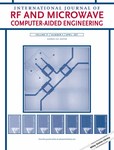Design of periodic wideband pixel absorber by genetic algorithm combined with internal multi-port method
Funding information: National Natural Science Foundation of China, Grant/Award Number: 61731005
Abstract
A periodic wideband pixel absorber is designed by genetic algorithm (GA) combined with a fast circuit simulation method, namely, the internal multi-port method (IMPM). In order to achieve a wideband absorption effect, the pixel connections of the absorber are optimized by GA into three states, that is, metal connection (no loss), disconnection, and lossy connection states. In the optimization, the performance of the pixel absorber is evaluated quickly by the IMPM, rather than by the time-consuming full wave simulation. To validate the optimization performance, the optimized wideband absorber is simulated, fabricated and measured. The simulation and measurement results show that the absorber can achieve an 85% (5.5-13.6 GHz) bandwidth with the absorptivity higher than 90%. Besides, the absorber is insensitive to the polarization and incidence angle of the waves.
Open Research
DATA AVAILABILITY STATEMENT
Research data are not shared.




